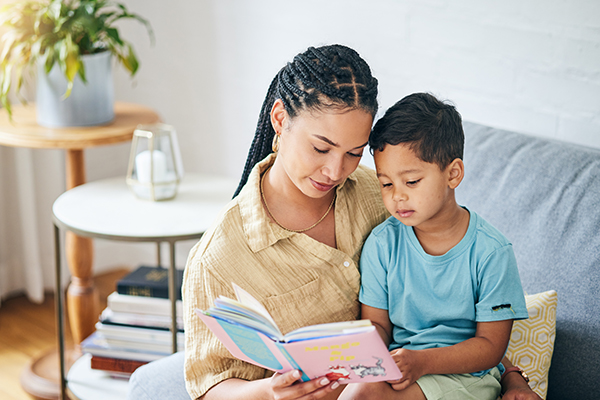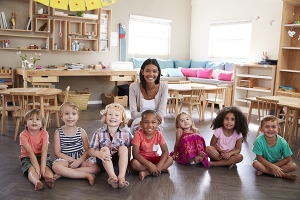
Did you know that interactive storytelling supports social-emotional learning (SEL) and the development of literacy skills? That’s right—sharing stories actually teaches children to build relationships, self-regulate behavior, listen attentively and communicate effectively. Interactive storytelling also inspires imagination, improves academic performance and boosts mental wellness. Not only is that really important stuff, but it's in stark contrast to what happens when kids spend hours on cell phones and other technology.
According to CASEL (Collaborative for Academic, Social and Emotional Learning), "SEL is the process through which young people and adults acquire and apply the knowledge, skills and attitudes to develop healthy identities, manage emotions and achieve personal and collective goals, feel and show empathy for others, establish and maintain supportive relationships, and make responsible and caring decisions." Take note, Parents: It's important to keep this in mind as you consider how your family spends their time. Excessive screentime actually hinders all of these benefits.
There are countless good reasons to spend dedicated time each day sharing stories, reading books and engaging interactively with your children. If you’re not sure how to get started, read on for expert tips to improve storytelling skills.
WHAT IS INTERACTIVE STORYTELLING?
There is nothing wrong with reading books to children in a straightforward manner. That said, it’s easy, fun and even more beneficial to maximize the storytelling experience by making a few minor adjustments.
The main goal is to actively involve children in the storytelling process, instead of just reading the words on the page. Danielle Dietz-Harris, a speech-language pathologist at Pathways.org, describes interactive storytelling as a reading technique that includes commenting, asking questions, responding and giving adequate time to respond.
“To boost the impact of your read-aloud time at home, parents can take their time going through the story and include the child as an active participant,” says Kaydon Schanberger, Director of the Educational Psychology Department at San Diego Kids First. “Pause, look at the pictures and ask about what they are seeing. Take time to read the facial expressions and body language of the characters. Parents can also ask questions that offer opportunities for children to make inferences, draw conclusions or set predictions.”
WHY IS INTERACTIVE STORYTELLING IMPORTANT?
"Reading aloud and storytelling are important components of your child’s social and emotional development,” says Schanberger. “They can help build a child’s ability to understand and practice empathy, social-awareness and relationship skills through the non-threatening lens of a character. This provides an opportunity to practice common social issues before or after they occur.”
Schanberger adds that interactive storytelling helps children better understand different situations, experiences and social norms that may be complex or confusing. It provides a model for navigating relatable experiences with successful outcomes, allowing children to prepare for new experiences or upcoming changes.
To learn more about SEL, visit www.sdcoe.net/students/health-well-being/virtual-wellness-center/social-emotional-learning.
HOW CAN PARENTS IMPROVE STORYTELLING SKILLS?
To advance your own storytelling skills, Dietz-Harris suggests introducing new books with an interactive “picture walk” before reading the actual story. Engaging with a child in this way builds interest in the story, previews concepts and vocabulary, and ultimately improves the read-aloud experience. During a second book exposure, she recommends reading some of the pages aloud while continuing to discuss the pictures and events the child remembers from the initial exposure.
To further improve storytelling skills:
- Notice what the child is interested in on the page; then comment on it.
- Wait for their response.
- Repeat their response and add a little more information.
- Ask questions.
- Predict what will happen next.
- Relate storybook events to your own lives.
- Role-play or act out the story with your child.
- Use props like puppets or stuffed animals to tell the story.
“Kids learn many things from stories, including cause and effect, the rules of a language (syntax/grammar), and appropriate moral and ethical behavior,” says Dietz-Harris. “I think the biggest takeaway for interactive storytelling is making sure it is a fun experience for children in which they feel included, not where an adult is simply reading word-for-word without any interaction.”
Schanberger suggests asking children any of the following questions while reading:
- Do you see their faces, what do you think they are feeling?
- Can you make that face, too?
- What is her body language telling us?
- Why do you think that hurt his feelings?
- How do you think he will react?
- How do you think they can fix it?
- Have you ever had a friend do ____?
- What do you think they should do next?
For additional read-aloud strategies, visit www.smartreading.org/strategies-for-reading-aloud-with-children.
WHAT ELSE SHOULD PARENTS KNOW?
Sharing stories is an important way to connect. Most kids love participating in interactive story time sessions, so always keep the focus on having fun. Create different voices for the characters, let kids turn the pages and find creative ways to make the story come alive.
Since regular exposure to reading is best, most experts recommend embedding story time into your daily routine, such as before naps or at bedtime. Evaluate what works best for your family, then cuddle up for some quality time together.
Children often enjoy re-reading favorite books. That’s great, but it’s also important to introduce new stories for further social-emotional learning and literacy development. Create a book-rich environment with regular visits to the library. Be sure to let children select books that appeal to them.
MORE RESOURCES
No library card? Register for free at www.sandiego.gov/public-library/services/lending/librarycard or visit your local library.
Parents of toddlers and preschoolers may wish to join 1,000 Books Before Kindergarten, a free literacy program through San Diego Public Library. For more information, go to www.sandiego.gov/1000books.
Lisa Pawlak is an award-winning contributing writer who lives in Encinitas with her family.

















